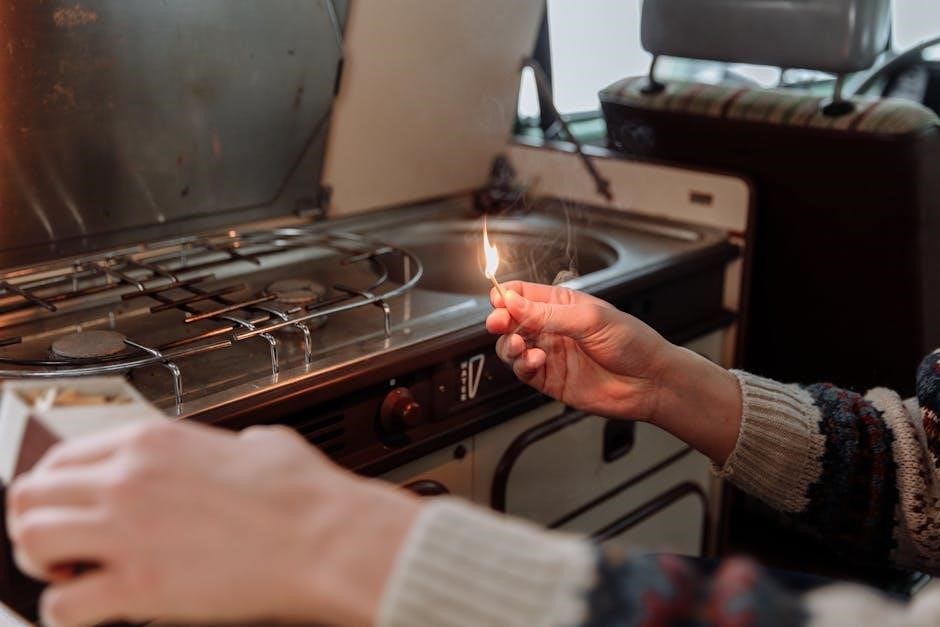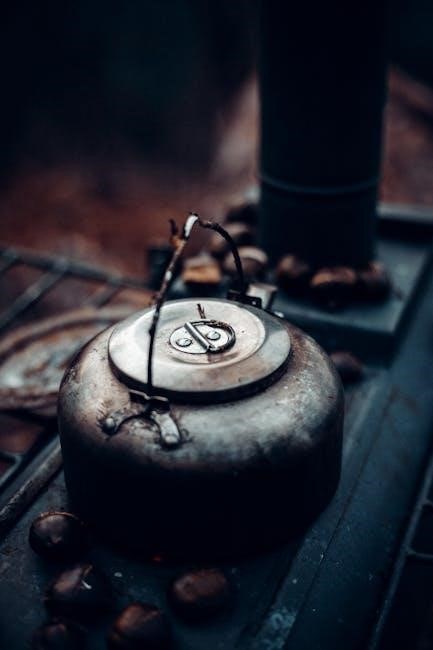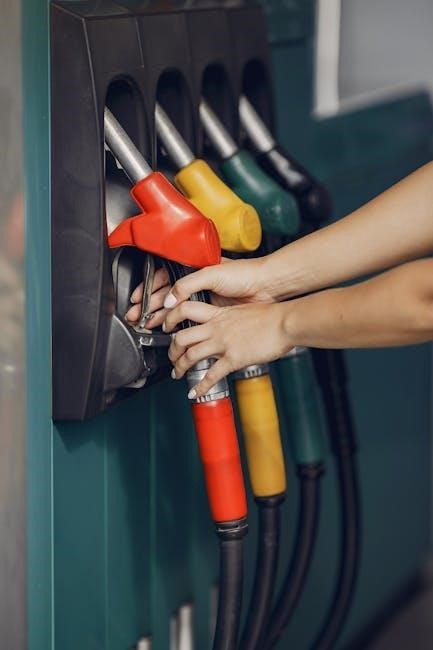The AquaCal Heat Pump Manual provides comprehensive guidance for installing, operating, and maintaining AquaCal heat pumps. It covers essential steps, safety precautions, and troubleshooting tips to ensure optimal performance and longevity of the system.
Overview of the AquaCal Heat Pump System
The AquaCal Heat Pump System is a high-efficiency, eco-friendly solution for heating and cooling water in residential and commercial settings. Designed to maximize energy savings, it operates by transferring heat from ambient air to water, ensuring consistent temperatures. The system is built with durable components, including advanced heat exchangers and smart control panels, to deliver reliable performance. Its compact design makes it suitable for various installations, while its quiet operation enhances user comfort. The AquaCal Heat Pump is ideal for pools, hot tubs, and water heating applications, offering a cost-effective alternative to traditional heating methods. Its innovative technology ensures optimal energy use and minimal environmental impact.
Importance of the Manual for Users
The AquaCal Heat Pump Manual is an essential resource for users, providing detailed instructions for safe and efficient operation. It ensures proper installation, maintenance, and troubleshooting, preventing potential damage and extending system lifespan. The manual outlines safety precautions, operational guidelines, and diagnostic procedures, empowering users to resolve common issues independently. By following the manual, users can optimize energy efficiency, reduce operational costs, and maintain warranty compliance. It serves as a comprehensive reference for understanding system functionality, ensuring users can harness the full potential of their AquaCal Heat Pump while minimizing risks and maximizing performance.
Structure and Content of the Manual
The AquaCal Heat Pump Manual is organized into clear sections for easy navigation. It begins with an introduction, followed by installation and setup instructions, operating guidelines, and maintenance procedures. The manual includes detailed diagrams, troubleshooting tips, and technical specifications to ensure comprehensive understanding. Key features such as safety precautions, energy efficiency settings, and compliance standards are highlighted throughout. Additional resources, like a glossary and index, enhance usability. This structured approach ensures users can quickly find relevant information, making the manual an indispensable tool for optimizing heat pump performance and addressing any challenges that arise during its lifespan.

Installation and Setup
The AquaCal Heat Pump Manual guides through pre-installation checks, step-by-step setup, and post-installation testing to ensure a smooth and correct system installation process properly.
Pre-Installation Requirements
Before installing the AquaCal Heat Pump, ensure the site meets specific criteria. The location must be level, well-ventilated, and protected from extreme weather conditions. Check for adequate electrical supply and plumbing connections. Ensure compliance with local building codes and regulations. Verify the system’s compatibility with your pool or spa dimensions. Prepare the installation area by clearing debris and ensuring proper drainage. Familiarize yourself with the manual’s safety guidelines and precautions. Confirm all necessary tools and materials are available. If unsure, consult a certified professional to avoid installation errors. Proper preparation ensures a smooth and safe installation process.
Step-by-Step Installation Guide
Begin by unpacking and inspecting the AquaCal Heat Pump for any damage. Locate the unit on a firm, level surface, ensuring proper drainage and ventilation. Connect the electrical supply according to the manual’s wiring diagram, adhering to local electrical codes. Attach the plumbing lines to the heat exchanger, ensuring all connections are secure and leak-free. Mount the control panel and connect it to the heat pump. Test the system by running a diagnostic cycle. Ensure all safety features are activated, such as pressure switches and thermal protectors. Double-check all connections and settings before finalizing the installation. Follow the manual’s sequence to avoid installation errors and ensure optimal performance. Proper alignment and secure fastening of all components are crucial for efficiency and durability.
Post-Installation Checks and Tests
After completing the installation, perform a series of checks to ensure the AquaCal Heat Pump operates safely and efficiently. Begin with a visual inspection of all connections, verifying that electrical and plumbing links are secure and free of leaks. Activate the system and monitor its startup sequence to confirm proper operation. Check the control panel for any error codes or alarms and ensure all safety features, such as pressure switches and thermal protectors, are functioning correctly. Conduct a test cycle under varying load conditions to assess performance and efficiency. Finally, review the installation against the manual’s guidelines to ensure compliance and optimal functionality.

Operating the AquaCal Heat Pump
Learn how to start up, monitor, and adjust settings for efficient operation. Understand the control panel, energy-saving features, and daily maintenance tips to ensure smooth performance and reliability.
Starting Up the System
Starting up the AquaCal Heat Pump involves several key steps to ensure safe and efficient operation. First, confirm that all electrical connections are secure and the power supply matches the system’s requirements. Next, perform a visual inspection to verify that all components are properly installed and free from damage. Turn on the power and allow the system to initialize, following the sequence outlined in the manual. Familiarize yourself with the control panel, setting the desired temperature and mode of operation. Once operational, monitor the system for any unusual noises or leaks. Always refer to the manual for specific startup procedures and safety guidelines to avoid potential issues.
Daily Operation and Monitoring
Daily operation of the AquaCal Heat Pump requires consistent monitoring to ensure optimal performance. Begin by checking the temperature settings and adjusting them as needed to maintain comfort and efficiency. Monitor the system’s pressure gauges and flow rates to ensure they are within the recommended ranges. Regularly inspect the filter and clean it if necessary to prevent reduced airflow or efficiency. Listen for unusual noises and visually inspect connections for leaks. Keep a log of daily operations to track performance and identify potential issues early. Refer to the manual for specific monitoring guidelines and maintenance schedules to ensure the system runs smoothly and efficiently over time.
Adjusting Settings for Optimal Performance
Adjusting the AquaCal Heat Pump settings ensures maximum efficiency and comfort. Start by setting the desired temperature, considering factors like ambient conditions and usage patterns. Use the control panel to fine-tune settings, such as temperature range, fan speed, and timer functions. Ensure pressure levels and flow rates are within the recommended ranges specified in the manual. Regularly check and adjust these settings to adapt to changing conditions, such as seasonal variations or increased demand. Refer to the manual for specific guidelines on optimizing settings for your system. Proper adjustments will enhance performance, reduce energy consumption, and extend the lifespan of the heat pump. Always monitor the system after making changes to ensure stability and efficiency.

Maintenance and Upkeep
Regular maintenance ensures the AquaCal Heat Pump operates efficiently. Schedule filter cleaning, inspect components, and perform routine checks as outlined in the manual to prevent issues.
Scheduled Maintenance Tasks
Regular maintenance is crucial for optimal performance. Schedule tasks like filter cleaning every 1-3 months, depending on usage. Inspect heat exchangers and refrigerant lines annually for leaks or damage. Check electrical connections and tighten if necessary. Replace worn-out seals or gaskets to prevent water leaks. Clean the exterior to ensure proper airflow. Test safety devices and alarms to confirm they function correctly. Lubricate moving parts as recommended. Monitor system pressure and adjust as needed. Keep a maintenance log to track tasks and identify potential issues early. Always refer to the manual for specific intervals and procedures tailored to your AquaCal model.
Troubleshooting Common Issues
Identify and address issues promptly to maintain efficiency. Common problems include the system not heating or cooling, unusual noises, or error codes. Check power supply and circuit breakers if the unit doesn’t turn on. Inspect for refrigerant leaks or blockages in airflow. Clean filters and coils to ensure proper function. For noise issues, tighten loose parts or replace worn components. Refer to the error code list in the manual for specific diagnoses. Test sensors and thermostats for accuracy. Ensure proper water flow and pressure to prevent system strain. If issues persist, contact a certified technician for professional assistance. Regular troubleshooting ensures optimal performance and extends the system’s lifespan.
Replacing Parts and Accessories
Regularly inspect and replace worn or damaged parts to maintain optimal performance. Identify components needing replacement, such as filters, seals, or sensors, and purchase genuine AquaCal accessories. Turn off power before starting any replacement to ensure safety. Follow step-by-step instructions in the manual for proper installation. Use specialized tools if required, and refer to diagrams for clarity. After replacing parts, test the system to ensure functionality. Keep a record of replacements for future reference. If unsure, consult a certified technician to avoid system damage. Replacing parts promptly prevents further issues and extends the heat pump’s lifespan while maintaining efficiency and reliability. Always follow safety guidelines during replacements.

Troubleshooting and Repair
This section guides users through identifying and resolving common issues with the AquaCal heat pump. It provides step-by-step solutions for error codes, system malfunctions, and repair procedures.
Identifying Common Errors and Alarms
The AquaCal heat pump manual outlines common errors and alarms to help users quickly diagnose issues. Error codes are displayed on the control panel, indicating specific system malfunctions, such as temperature fluctuations, low refrigerant levels, or sensor failures. Alarms may sound for high pressure, low flow, or overheating. The manual provides a list of error codes with descriptions, enabling users to identify the root cause of the problem. This section also guides users on how to reset the system after addressing the issue. Regularly reviewing this section ensures users can troubleshoot effectively, minimizing downtime and maintaining optimal performance. Proper identification of errors is crucial for timely repairs and system longevity.
Diagnosing System Malfunctions
Diagnosing malfunctions in the AquaCal heat pump involves a systematic approach to identify the root cause of issues. Start by checking error codes displayed on the control panel, which provide specific fault indicators. Common issues include temperature sensor malfunctions, refrigerant leaks, or compressor failures. Use a multimeter to test electrical connections and verify voltage levels. Inspect the system for visible damage, such as corroded coils or blocked airflows. Consult the manual for troubleshooting charts and flow diagrams to isolate the problem. Always refer to the manual’s diagnostic procedures to ensure accurate repairs and prevent further damage. Regular system checks can help detect potential issues before they escalate, ensuring reliable operation and energy efficiency.
Repairing and Restoring Functionality
Repairing and restoring functionality of the AquaCal heat pump requires careful adherence to the manual’s guidelines. Begin by identifying the faulty component and gathering necessary tools and replacement parts. Always disconnect power before starting repairs to ensure safety. For complex issues, such as compressor or heat exchanger damage, consult a certified technician. Replace worn or damaged parts with genuine AquaCal components to maintain system integrity. After completing repairs, perform a thorough system test to verify proper operation. Refer to the manual’s troubleshooting section for specific repair procedures and ensure all connections are secure. Regular maintenance and timely repairs are crucial for restoring functionality and preventing future malfunctions.

Technical Specifications
The AquaCal heat pump manual details key components, performance metrics, and operational standards, ensuring efficiency and compliance with industry regulations for reliable heating and cooling solutions.
Key Components of the Heat Pump
The AquaCal heat pump consists of essential components designed for efficient heating and cooling. These include a compressor for compressing refrigerant, a heat exchanger to transfer heat, and a fan coil for air circulation. Additionally, the system features a controller for operational management, sensors for temperature monitoring, and a reversible valve to switch between heating and cooling modes. These components work together to ensure optimal performance, energy efficiency, and reliable operation. Understanding each part is crucial for proper installation, maintenance, and troubleshooting, as detailed in the manual.
Performance Metrics and Efficiency Ratings
The AquaCal heat pump is designed to deliver exceptional performance with high energy efficiency. It boasts a Seasonal Energy Efficiency Ratio (SEER) of up to 18 and an Energy Efficiency Ratio (EER) of 12.5, ensuring minimal energy consumption. The system also features a Coefficient of Performance (COP) of 5.0, indicating its ability to efficiently convert energy into usable heat. These ratings ensure the heat pump operates effectively across various temperature ranges, providing consistent heating and cooling while reducing energy costs. The manual highlights these metrics to help users understand the system’s capabilities and optimize its performance for their specific needs.
Compliance with Standards and Regulations
The AquaCal heat pump is meticulously designed to meet stringent industry standards and regulations. It adheres to ASHPRAE standards for heating and cooling systems, ensuring reliability and safety. The system is also UL-certified, confirming its compliance with safety protocols for electrical and heating devices. Additionally, it meets Energy Star requirements, recognizing its high energy efficiency and environmental performance. The manual provides detailed information on certifications and regulatory compliance, offering users assurance of a safe and eco-friendly operation. This adherence to standards not only enhances system performance but also aligns with global sustainability goals, making the AquaCal heat pump a responsible choice for modern heating needs.

Environmental and Safety Considerations
The AquaCal heat pump is designed with eco-friendly features, minimizing environmental impact. It adheres to strict safety standards, ensuring safe operation and energy efficiency for users.
Eco-Friendly Features of the System
The AquaCal heat pump is designed with eco-friendly features to minimize environmental impact. It uses renewable energy from water and air, reducing reliance on fossil fuels. The system operates with high energy efficiency, lowering carbon emissions. Additionally, it uses environmentally friendly refrigerants that have minimal ozone-depleting potential. The heat pump’s quiet operation and durable construction reduce noise pollution and extend its lifespan, minimizing waste. Recyclable components further enhance its sustainability. These features make the AquaCal heat pump an environmentally responsible choice for heating and cooling needs, aligning with global efforts to reduce carbon footprints and promote sustainable energy solutions.
Safety Precautions and Guidelines
Operating the AquaCal heat pump requires adherence to safety precautions to ensure safe and efficient functionality. Always follow the manufacturer’s instructions and wear protective gear when handling electrical or mechanical components. Avoid exposing the system to extreme temperatures or corrosive substances. Ensure proper ventilation to prevent gas buildup. Regularly inspect electrical connections and refrigerant lines for leaks or damage. Keep flammable materials away from the unit. Never attempt repairs without disconnecting power. Follow local safety regulations and guidelines for installation and maintenance. Proper training is recommended for technical adjustments. Maintain a safe distance from moving parts and avoid overloading the system. Regular maintenance by certified professionals is essential to uphold safety standards and prevent potential hazards.
Disposal and Recycling Instructions
Proper disposal and recycling of the AquaCal heat pump are crucial for environmental protection. Always adhere to local regulations and guidelines for handling electrical and mechanical components. Refrigerants must be safely extracted by certified professionals to prevent atmospheric damage. Electrical parts should be recycled through approved facilities to recover valuable materials. Metal components can be responsibly recycled, reducing landfill waste. Ensure all fluids and chemicals are drained and disposed of in an eco-friendly manner. Consult local authorities or the manufacturer for specific instructions tailored to your region. Proper disposal helps conserve resources and minimizes environmental impact, aligning with sustainable practices.
The AquaCal Heat Pump Manual provides essential guidance for efficient, eco-friendly operation. Proper usage ensures optimal performance, energy savings, and environmental benefits, adhering to safety and maintenance guidelines.
The AquaCal Heat Pump Manual is a comprehensive guide designed to help users understand and effectively utilize their heat pump system. It covers installation, operation, maintenance, and troubleshooting, ensuring optimal performance and longevity. Key points include proper installation techniques, daily monitoring, and scheduled maintenance tasks to prevent malfunctions. The manual also emphasizes energy efficiency, eco-friendly operation, and compliance with safety standards. By following the guidelines, users can maximize their system’s efficiency, reduce energy costs, and enjoy reliable heating and cooling. Adhering to the manual’s instructions ensures a safe, environmentally responsible, and cost-effective experience with the AquaCal Heat Pump.
Final Tips for Effective Usage
To maximize the efficiency and lifespan of your AquaCal Heat Pump, regularly review and follow the manual’s guidelines. Schedule routine maintenance to prevent issues and ensure optimal performance. Adjust settings according to seasonal changes and usage patterns to save energy. Keep the system clean and free from debris to maintain airflow and efficiency. Monitor temperature settings and adjust them when possible to reduce energy consumption. Finally, consult the troubleshooting section for quick solutions to common problems. By adhering to these tips, you can enjoy reliable, eco-friendly, and cost-effective heating and cooling with your AquaCal Heat Pump.
Resources for Further Assistance
For additional support, refer to the official AquaCal website, which offers detailed product guides, FAQs, and troubleshooting resources. Contact AquaCal’s customer support team directly for personalized assistance. Authorized dealers and distributors can also provide expert advice and spare parts. Online forums and communities dedicated to heat pump users often share valuable insights and solutions. Ensure to consult certified professionals for complex repairs or installations. Regularly check for software updates and maintenance tips on the AquaCal portal. These resources will help you maximize the performance and longevity of your heat pump system.